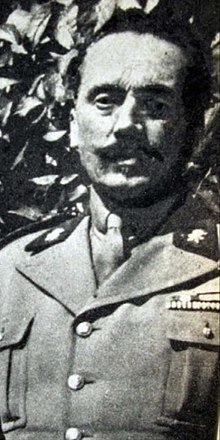Emanuele Balbo Bertone
Emanuele Balbo Bertone | |
|---|---|
 | |
| Born | 9 August 1886 Chieri, Kingdom of Italy |
| Died | 28 January 1945 (aged 58) Kuźnica Żelichowska, Poland |
| Allegiance | |
| Service | |
| Years of service | 1909-1945 |
| Rank | Brigadier General |
| Commands | 4th Coastal Brigade |
| Battles / wars | |
| Awards |
|
Count Emanuele Balbo Bertone di Sambuy, Marquess of Breme (9 August 1886 – 28 January 1945) was an Italian general during World War II.
Biography
He was born into an aristocratic family, the son of Raimondo Balbo Bertone, Count of Sambuy, who died before his birth. He was initiated into a military career starting to attend the Royal Academy of Infantry and Cavalry in Modena graduating on 19 September 1909 with the rank of cavalry second lieutenant, under the cavalry weapon, assigned to the "Piemonte Reale" Cavalry Regiment. He participated with this regiment in the Italo-Turkish war, where he was awarded a Bronze Medal of Military Valor for having distinguished himself in the battles Ain Zara and of Zanzur. On 17 October 1912, with the rank of lieutenant, he became the adjutant of lieutenant general Pietro Frugoni. After promotion to captain, he took part in the First World War, commanding his regiment’s 240 mm bombard battery and earning a second bronze medal for military valor.
At the end of the war he was made redundant and placed on leave at his request from 1 July 1920, returning to his residence in Turin. Having been promoted to major in the Army reserve on 31 March 1926 and to lieutenant colonel in December 1929, he was recalled into active service on 5 October 1935 and was assigned to the military zone of Turin. He was then again placed on leave and promoted to colonel on 1 January 1938; following Italy’s entry into the Second World War, on 12 June 1940 he was recalled into active service and assigned to the staff of Umberto of Savoy, Prince of Piedmont.[1][2][3]
He remained with the Prince after his promotion to brigadier general of the reserve, which took place on January 1, 1942, and from the following October 31 he was given command of the 4th Coastal Brigade in Tempio Pausania, Sardinia. He remained in Sardinia until March 24, 1943, when he returned to Turin, where he was attached to the local territorial defense command for special assignments; he later became president of the military tribunal of Florence, where he was at the time of the Armistice of Cassibile.

On 22 September 1943 he was captured by German troops and sent to Oflag 64/Z in Schokken, Poland, where he remained until early 1945.[1][2][3]
With the Red Army reaching the Vistula in mid-January 1945, the Nazis decided to evacuate the camp and transfer the prisoners to Luckenwalde, south of Berlin, with a forced march. Along with other sixteen prisoners, Balbo Bertone stopped on the way in Kuźnica Żelichowska along with some companions, looking for food in a tavern, but they were noticed by a non-commissioned officer of the Luftwaffe and reported to the SS. As the march resumed, the SS started shooting the prisoners who were unable to walk fast enough to keep pace with the main group; Balbo Bertone was the second to be killed, after General Carlo Spatocco. After him generals Alberto Trionfi, Alessandro Vaccaneo, Giuseppe Andreoli and Ugo Ferrero were likewise murdered. Balbo Bertone was buried by the locals in the village cemetery.[2][4][3][5][6][7][8][9][10]
References
- ^ a b "Biography of Bigradier-General Emanuele Balbo Bertone (1886 – 1945), Italy". www.generals.dk.
- ^ a b c "Chi era Costui - Scheda di Emanuele Balbo Bertone di Breme". www.chieracostui.com.
- ^ a b c "MUSEO DIFFUSO TORINO - PIETRE D'INCIAMPO". pietre.museodiffusotorino.it.
- ^ "LE PIETRE D'INCIAMPO IN TANTE CITTÀ - la Repubblica.it". Archivio - la Repubblica.it. 10 January 2018.
- ^ "RASSEGNA DELL'ESERCITO 2008 N.3 by Biblioteca Militare - Issuu". issuu.com. 9 June 2018.
- ^ "Alberto Trionfi".
- ^ "A Torino otto nuove pietre d'inciampo per non dimenticare". January 24, 2018.
- ^ "Reference at anei.it" (PDF).
- ^ "www.ildialogo.org I.M.I. La testimonianza della figlia del generale Alberto Trionfi,di Maria Trionfi". www.ildialogo.org.
- ^ Cintoli, Paola (March 10, 2017). Il ritorno da Schokken Lager 64Z: Diario del Generale Giuseppe Cinti (1945): una voce della Resistenza senza armi. Bibliotheka Edizioni. ISBN 9788869340864 – via Google Books.
- 1886 births
- 1945 deaths
- Italian military personnel of World War I
- Italian military personnel killed in World War II
- Recipients of the Bronze Medal of Military Valor
- Recipients of the Silver Medal of Military Valor
- Italian generals
- Executed military leaders
- Italian people executed by Nazi Germany
- Lists of stolpersteine in Italy
- People executed by Nazi Germany by firearm
- People executed by Nazi Germany occupation forces
- Deaths by firearm in Poland
- Italian prisoners of war in World War II
- World War II prisoners of war held by Germany
- Italian people executed abroad
